Why do people search for what they do?
What motivates their questions, and what are they hoping to find?
These questions highlight the importance of search intent, a key consideration in developing an effective SEO strategy for delivering valuable and relevant content to your target audience.
In this article, we’ll look closely at five search intent tools to help you understand what your audience is seeking.
We’ll also discuss:
- Why search intent is important and its various types
- How you can determine search intent
And obviously share the best search intent tools!
Table of Contents
Why You Should Care About Search Intent
Search intent is the raison d’etre or the “reason of being” underlying a user’s query.
It explains the user’s question and why it is being asked.
One might say it discloses the hidden agenda behind a user’s question.
When you understand the intent behind the question, you can also figure out where a user is in the customer journey.
Are they casually browsing for information or comparing products?Either activity hints at a peculiar type of search intent, which can be better understood as below:
- Informational: This is an awareness stage during which users are still learning and gathering information about a topic, product, or service.
- Navigational: The intent is clearer in this stage. Users know what they want, and they’re trying to get direct access to it.
- Commercial: At this stage, the user has some preliminary information but wants to perform secondary research by comparing multiple products or services.
- Transactional: The user’s intent at this stage is the clearest. The user has finished learning and researching about a product and is now ready to make a purchase.
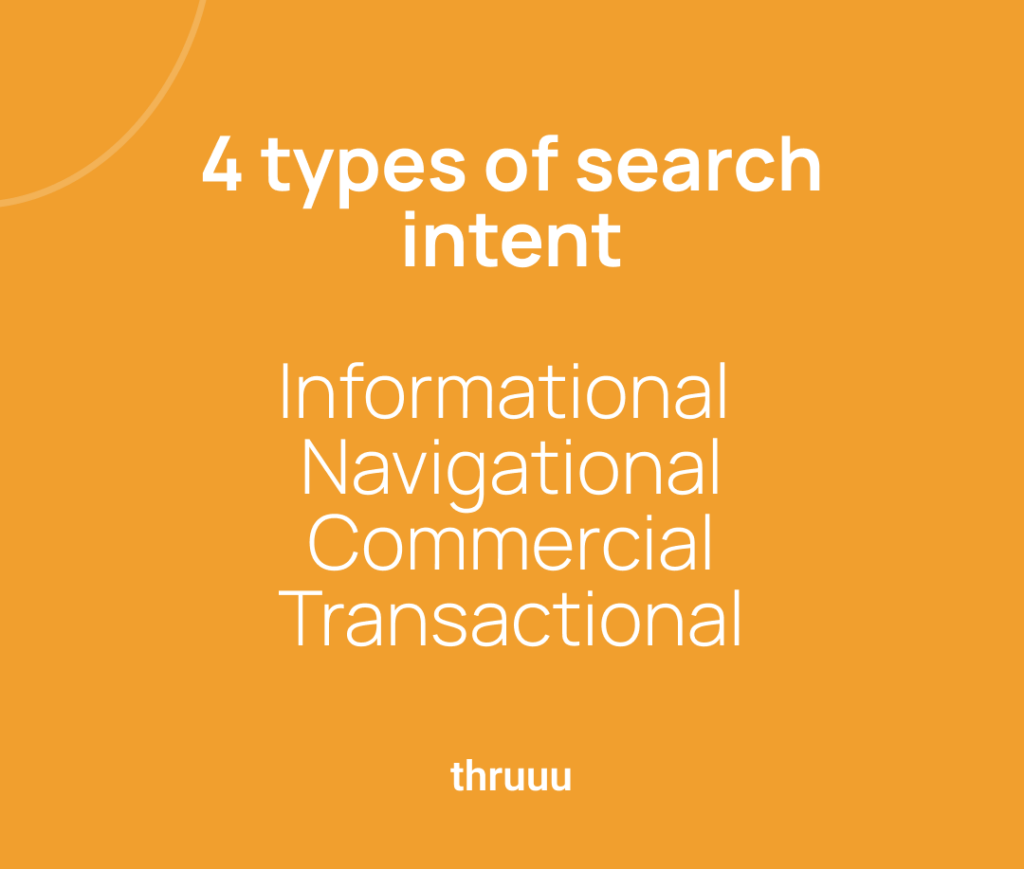
People love nothing more than finding the exact answer to their question after hitting “enter.”
After identifying the user’s intent type, you can shape your content to answer the questions they’re asking and give them the needed information.
For example, if they’re at the informational stage, you could craft an educational blog post about your product or service.
A detailed product listicle might be more useful if they are at the commercial stage.
Tweaking your content based on user intent type prompts search engines to prioritize and push your content to the top because it best addresses users’ search intent for a certain keyword.
How to Determine Search Intent
You can spot and identify search intent by analyzing the search engine results page (SERP). Here’s how you can do this:
Check the Display Pages: Search engines tailor their results and display only the pages they believe meet the user’s intent. As a result, various search intent types will provide different page results.
For example, SERPs showcasing DIY blog posts and “how-to” guides are geared toward educational content, implying that the user intent is most likely informational.
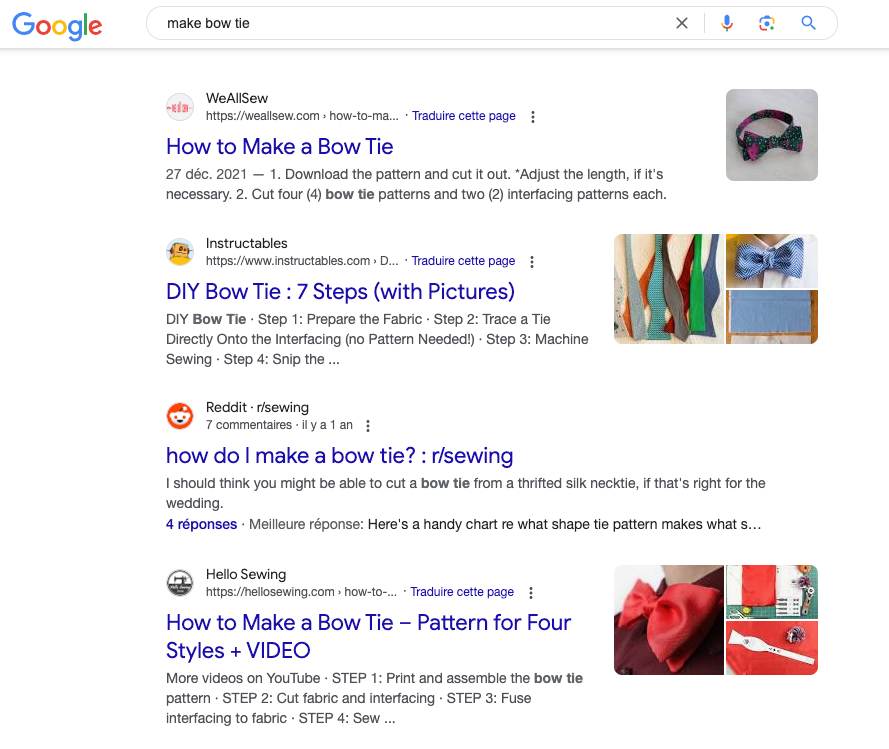
Check the “People Also Ask” (PAA) Box: The PAA box is a strong indicator of user intent because it lists a number of questions related to or similar to the original inquiry.
If the questions are more information-directed and offer explanations or definitions, they reflect informational intent. If they are more action-centric or transactional-focused, they indicate commercial or transactional intent.
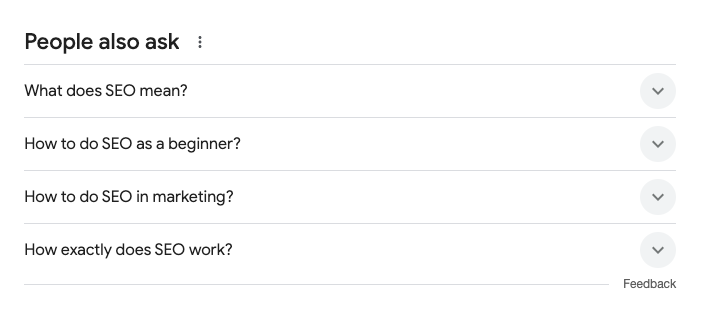
Review Other SERP Features: Aside from the page results and the PAA box, elements such as maps and product listings also clue you into the type of search intent behind the query.
If the SERP displays a series of maps or nearby stores, it signals commercial or transactional intent where the user intends to shop for a product at a certain store.
Product listings featured on the SERP page can point to commercial intent, indicating that users may be searching for or comparing different products.
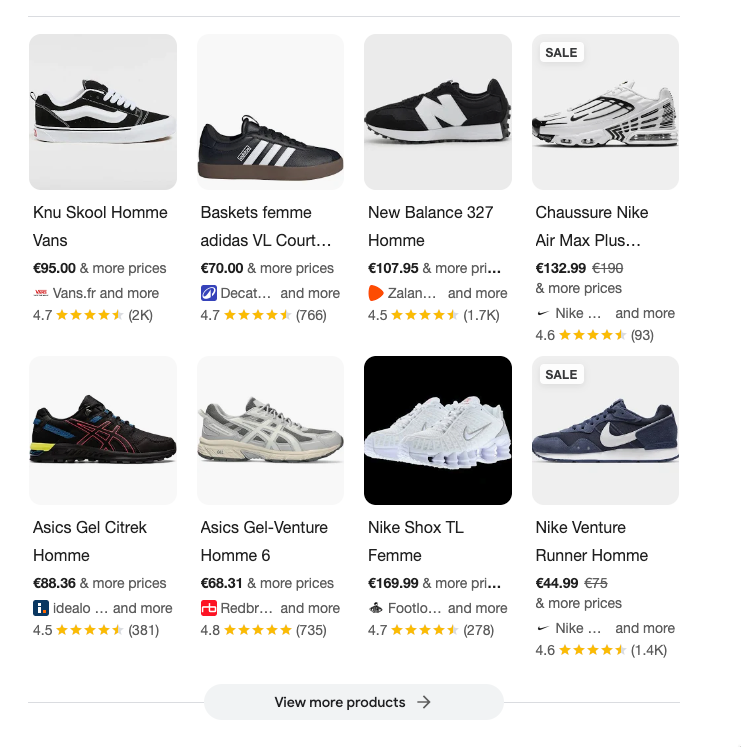
Article/Content Format: How content or articles are presented on the first page of search results strongly signals the search intent behind them. Accordingly, you can use a similar content strategy or emulate the format to address this intent, gradually working your way to the top of the page.
For example, if you notice that most articles respond to the user question in a listicle format or that most blog posts are image- or video-based, this is likely how users prefer their answers.
You can adopt the same strategy in your articles to answer the user query successfully and rank on the first page.
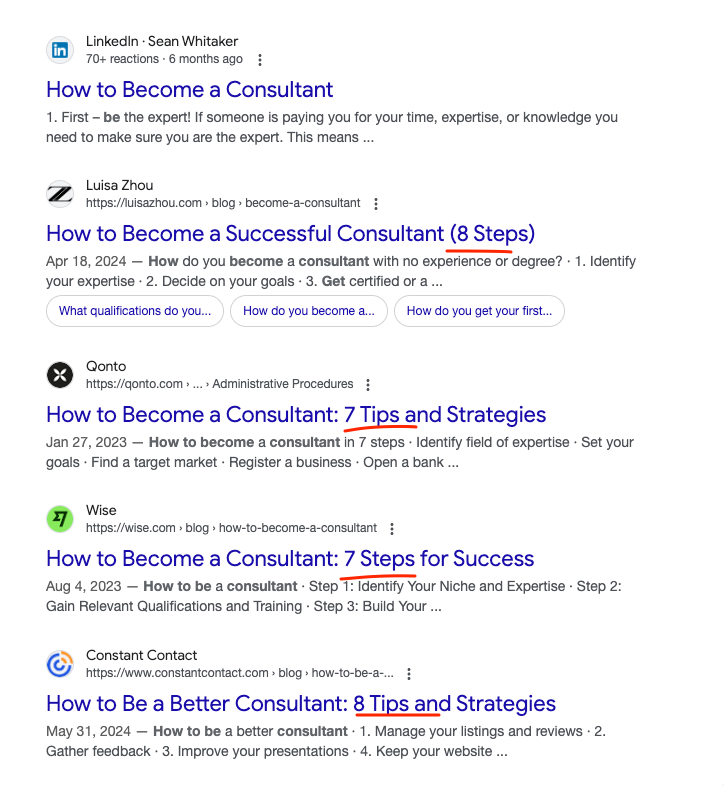
However, the above process requires considerable manual analysis, which may not always be feasible, especially if you need to analyze multiple user queries to determine intent.
This is where search intent tools make a huge difference.
Our Selection of Keyword Search Intent Tools
Marketers are not mind readers, but with the help of search intent tools, they come pretty close.
Here’s a list of our top five keyword search intent tools to get you started.
Google Search
Google Search takes most of the guesswork out of analyzing a user’s search intent and provides strong clues as to what it might be.
All you need to do is pay attention to Google Search Engine Result Pages (SERPs), which include features such as maps, the product ads being displayed, the PAA section, and the listings on its first page.
These elements will allow you to understand better what the user is looking for when they search for a specific keyword.
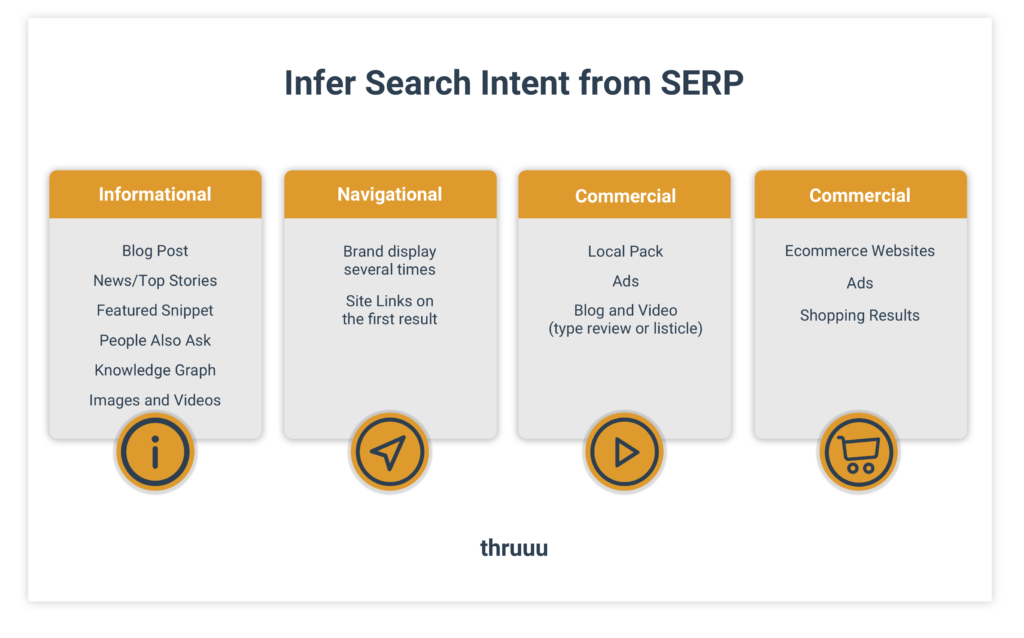
For example, when people search the keyword “washing machine” on Google, it could mean several things, including:
- The user is comparing washing machines.
- The user wants info on various types of washing machines.
- The user wants to buy a washing machine.
However, Google already knows the user’s transactional purpose, i.e., they want to buy a washing machine.
As a result, you are more likely to receive results that cater to this intent, such as product snippets with pricing pulled from e-commerce websites, map listings of nearby retailers selling washing machines, and sponsored ads from online stores.
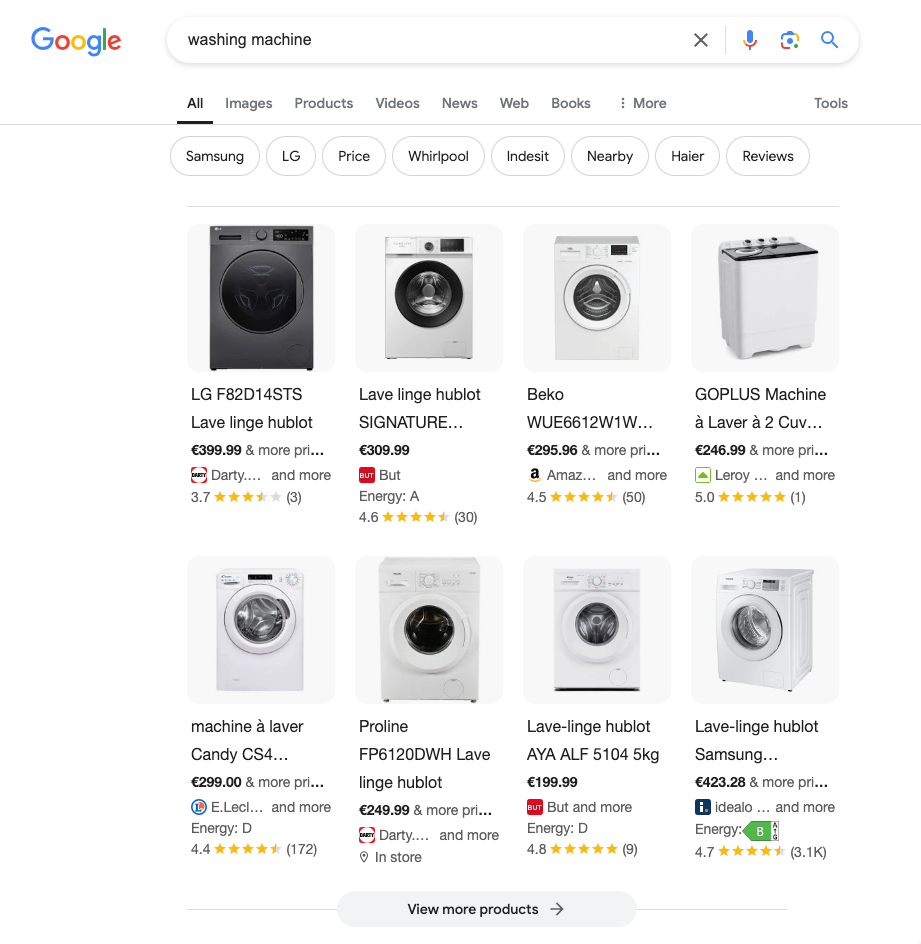
Alternatively, if you search for “how to repair phone screen,” Google will offer results relevant to the user’s informational journey. These may include how-to blog posts for fixing phone screens, videos offering DIY phone screen repair advice, or People Also Ask (PAA) questions related to your query.
Google search results provide valuable data you can use to create or optimize your own content for those keywords.
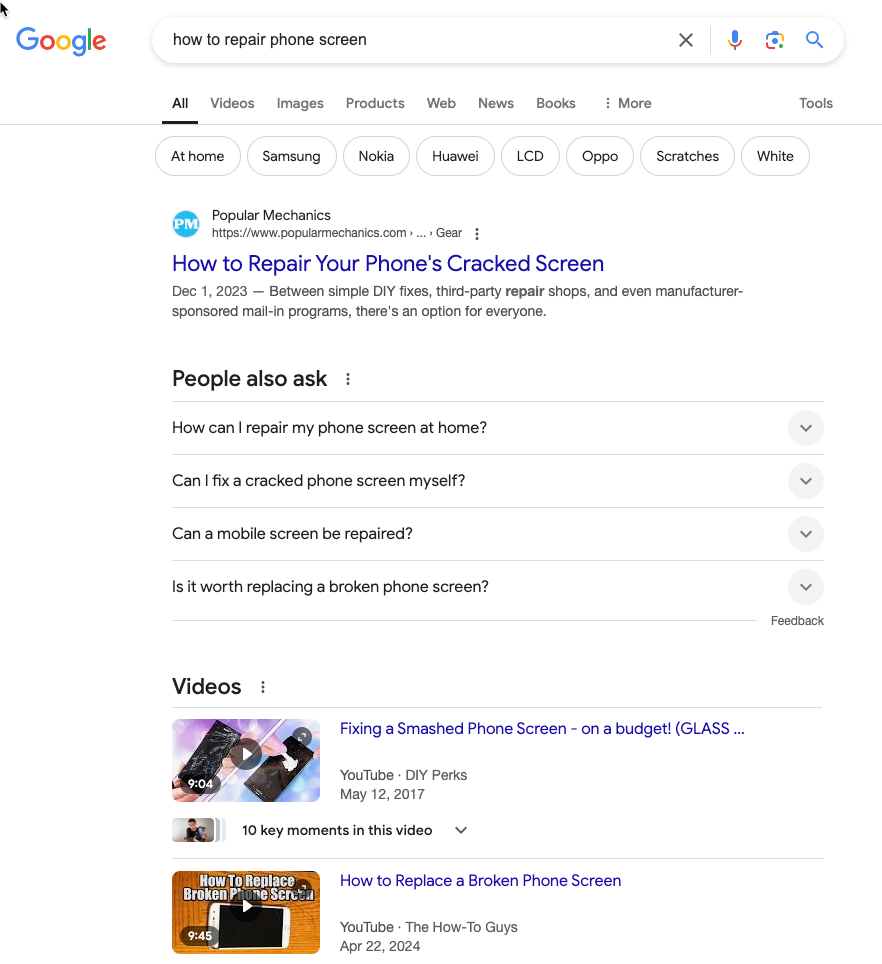
Pricing: Free
Alternative: Bing and Yahoo!
Google Search Console (GSC)
Google Search Console (GSC) is an excellent tool for understanding how users find their way to an indexed page or published content.
Specifically, it reveals which keywords or search terms drive visitors to your website or page.
Understanding this can help you plant the right keywords and refine your content to make it more relevant to your users’ search intent.
The best way to do this is to:
- Create a filter on your Google Search Console for your specific page.
- When you hit “apply,” GSC will reveal a list of all the search queries and keywords that drive traffic or clicks to your page
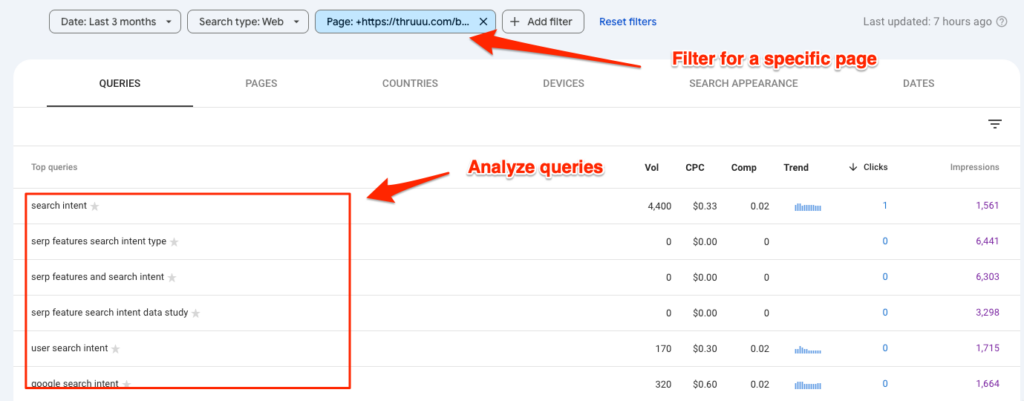
The insights you receive from these search queries can help you refine and level up your existing content — whether by using more of these keywords in your page or by expanding your page’s sections to incorporate some of the most common search terms.
This way, your content will better match user expectations and become more relevant. As a result, Google will prioritize your content over those that fail to meet or don’t adequately address users’ search intent.
Pricing: Free
Alternative: None
thruuu
thruuu is a versatile SEO tool that can help you peel back the layers around search intent and get to the heart of the matter. The beauty of it is that it has several tools to help you identify search intent.
First, you can try its SERP Analyzer tool, which helps you study your competitors’ pages to see the specific user intent they target and the search terms they frequently use.
The tool breaks down a Google SERP into categories, ranging from related topics to PAA questions. You can easily download SERP data for your convenience.
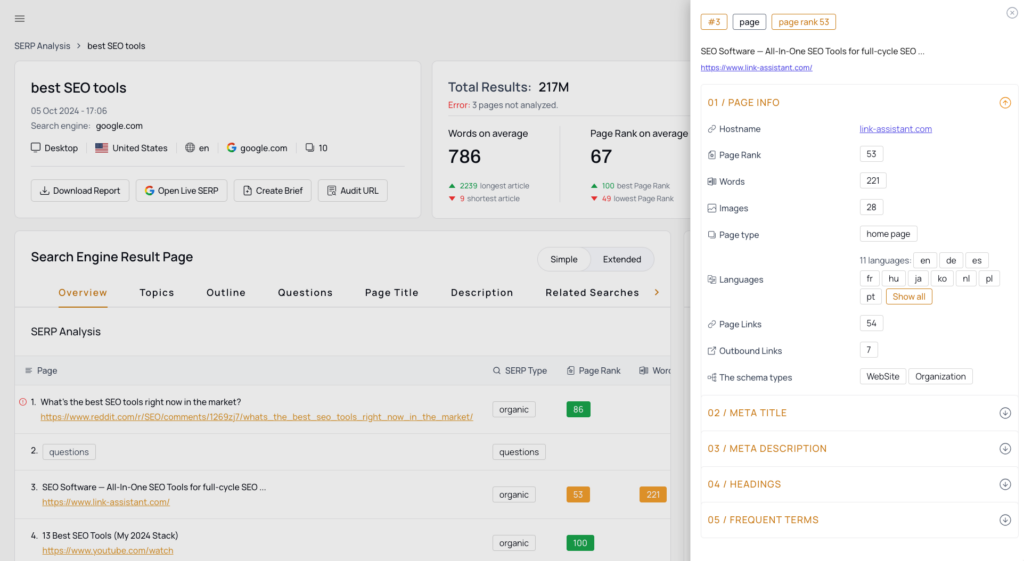
For example, if you search for the keyword “best SEO tools,” thruuu will return a list of common PAA questions related to this search query, such as “What is the most effective tool for SEO?” or “Which are the best SEO tools for a beginner?”
It will also generate a list of frequent on-page questions based on blog post headings and post comments.
This gives you a comprehensive list of search intent queries to target with your content.
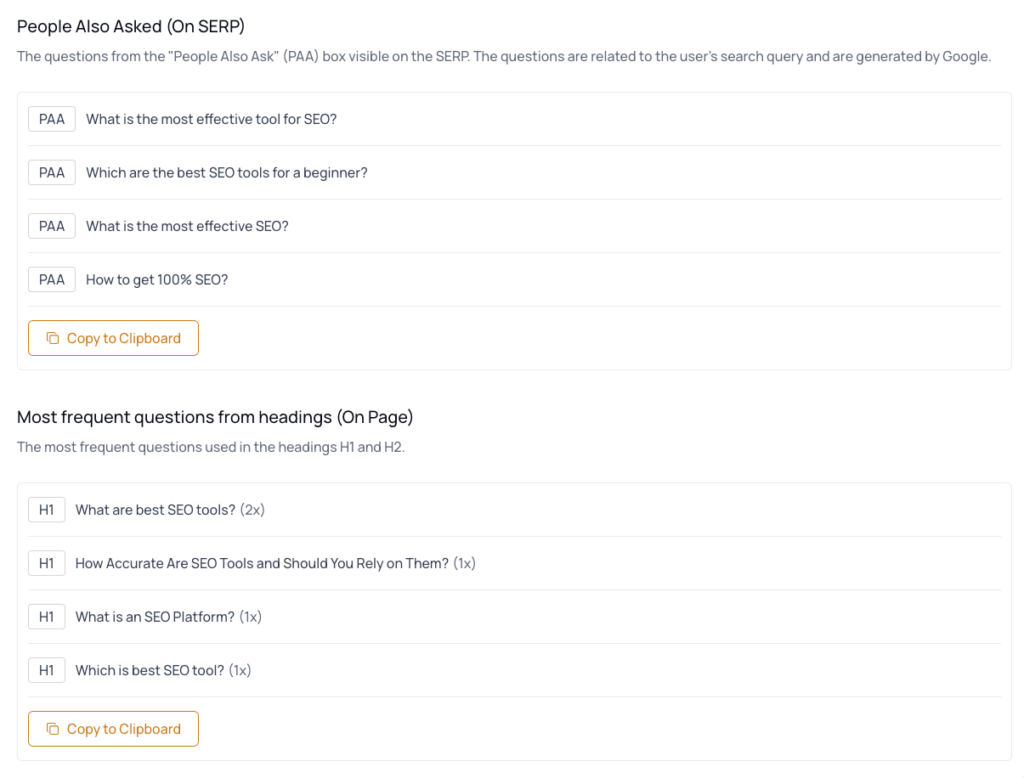
thruuu also has a “Top Topics” feature that offers insight into the most frequent terms associated with a keyword.
Not just that, clicking on a specific term reveals how a top-ranking article uses it in its content to address user intent.
You can then use this data to design your own content, thus helping you answer user queries more effectively.
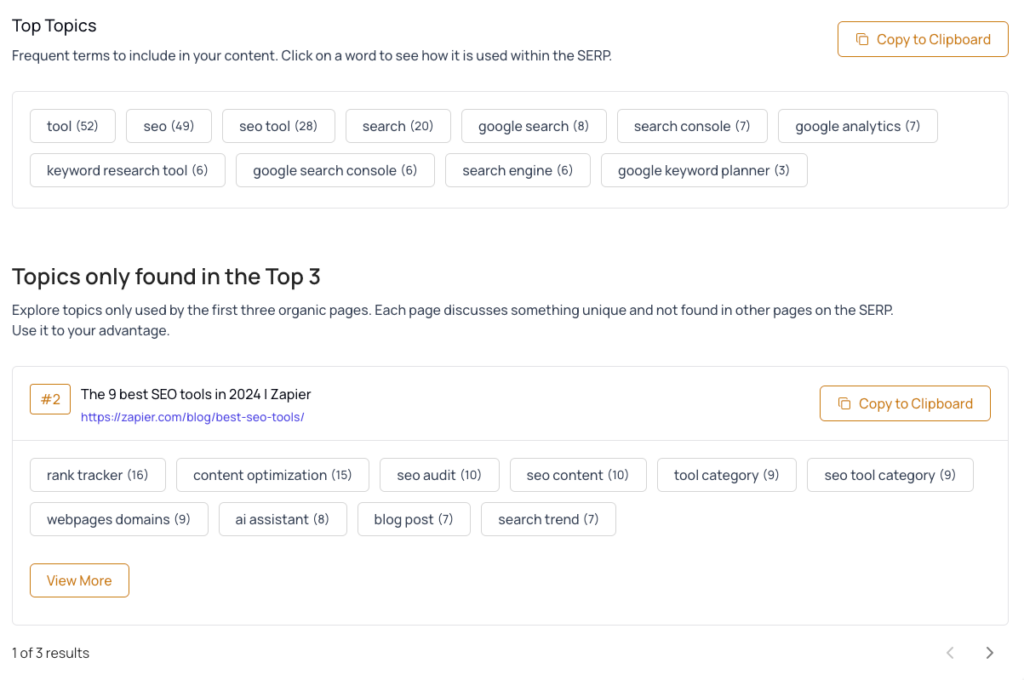
You can also run the Search Intent Analysis on autopilot with thruuu.
Simply open the “Summary & Intent” report in the SERP Analyzer and click Run analysis.
The Search Intent Tool adds a powerful layer of intelligence. Beyond identifying the main search intent, it also analyzes each page in the SERP individually, classifying results by format (listicle, guide, product, tool, etc.) and page intent (informational, commercial, transactional).
It then provides concise page summaries with user goals, along with an overall SERP synthesis and user highlights.
This means you instantly see what type of content dominates the query and how to align your own content strategy with it.
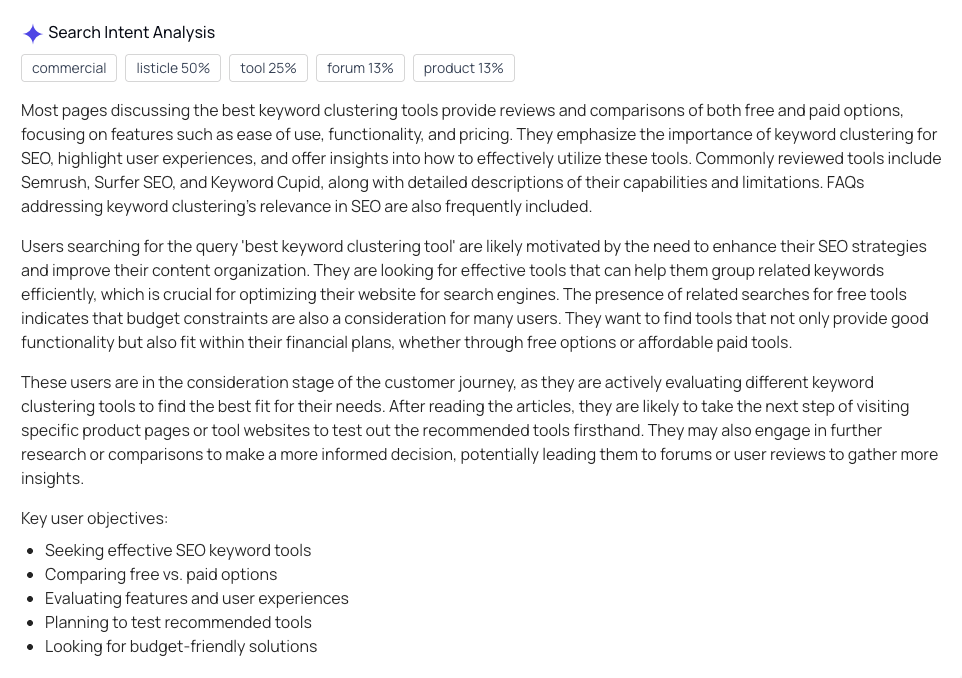
The Content Brief Generator is one of the thruuu’s best tools for assessing search intent.
You can also include the search intent for your blog within a brief. All you need to do is click the “AI Suggestion” button.
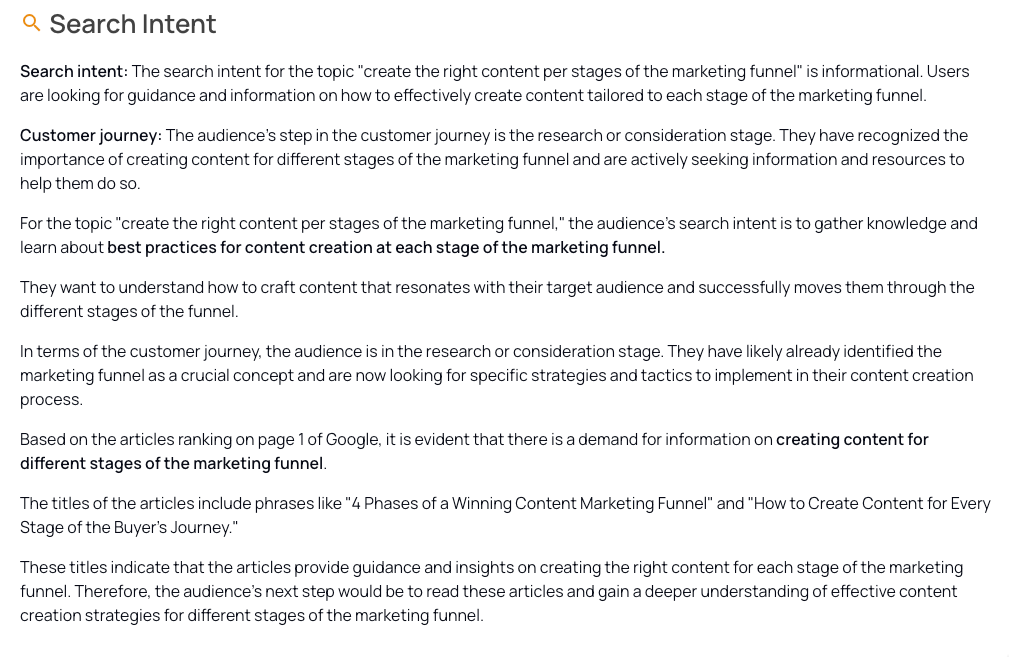
This intuitively generates a detailed search intent analysis based on insights from the top-ranking pages on Google’s first results page.
The analysis includes all the important search intent markers, such as:
- The customer journey the keyword caters to
- The type of questions users are seeking answers to
- The content users want to see covered in the article
Pricing: $19 to $99, depending on plan
Alternative: Market Muse, Clearscope
Analyze SERP and Search Intent
Our end-to-end content optimization solution empowers your team to crack the Google algorithm, craft exceptional content, and achieve remarkable organic search results.
SEMrush
While it does not have a direct search intent tool, SEMrush has various features to help you determine user intent, such as the Keyword Magic Tool.
Once you enter your keyword in the search box, you can select this tool from its sidebar to determine which stage of the customer journey it belongs to.
The tool then returns a list of the top-ranking keywords, with a corresponding search intent type for each, such as commercial, navigational, informational, or transactional.
It also gives you information about the volume, keyword density, and a look at the SERP page for that keyword, allowing you to refine your content strategy.
Another distinct feature of this tool is that you can filter the keyword list by intent to know which brings the most traffic to your competitors’ sites.
For example, if your seed keyword is “wicker furniture,” SEMrush will list related keywords such as “what is wicker furniture” (informational intent) or “buy wicker furniture” (transactional intent).
You can use the search intent filter to categorize the keywords and identify the top-ranking keywords for a specific user intent.
Alternatively, you can use the Organic Research tool to see which content formats perform best for specific queries on competitors’ pages. For instance, users are looking for informational content if a competitor’s page ranks high for educational blogs, tutorials, and how-to tips.
Pricing: $139 to $499, depending on plan
Alternative: Ahrefs
AnswerThePublic
AnswerThePublic is a user-friendly tool for learning about the questions users are most curious about for a certain topic. All you have to do is enter a keyword, and the tool generates a graphic network of the most pressing questions about that keyword.
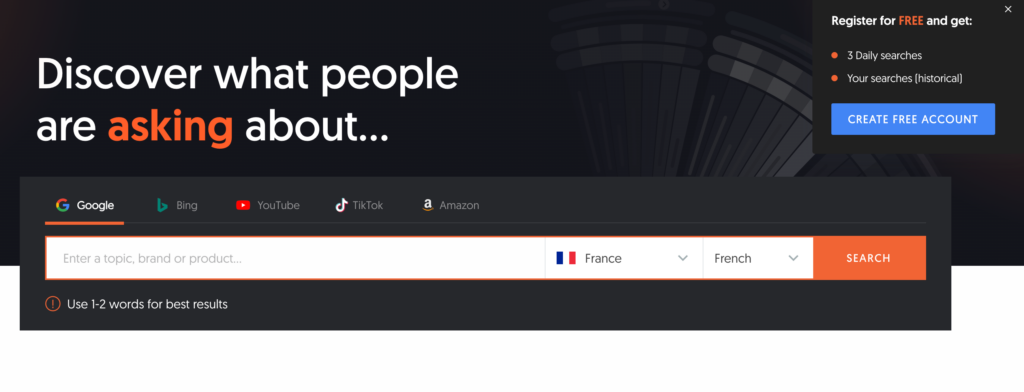
It arranges these questions into three categories: highly searched, average searched, and lowest searched, which are color-coded for easy understanding.
AnswerThePublic also provides a network of questions with prepositions. For example, if you search for “best laptops 2024,” it will generate questions that include prepositions, such as “best laptops 2024 for gaming” or “best laptops 2024 with touch screen.” It adds variety to your search intent data.
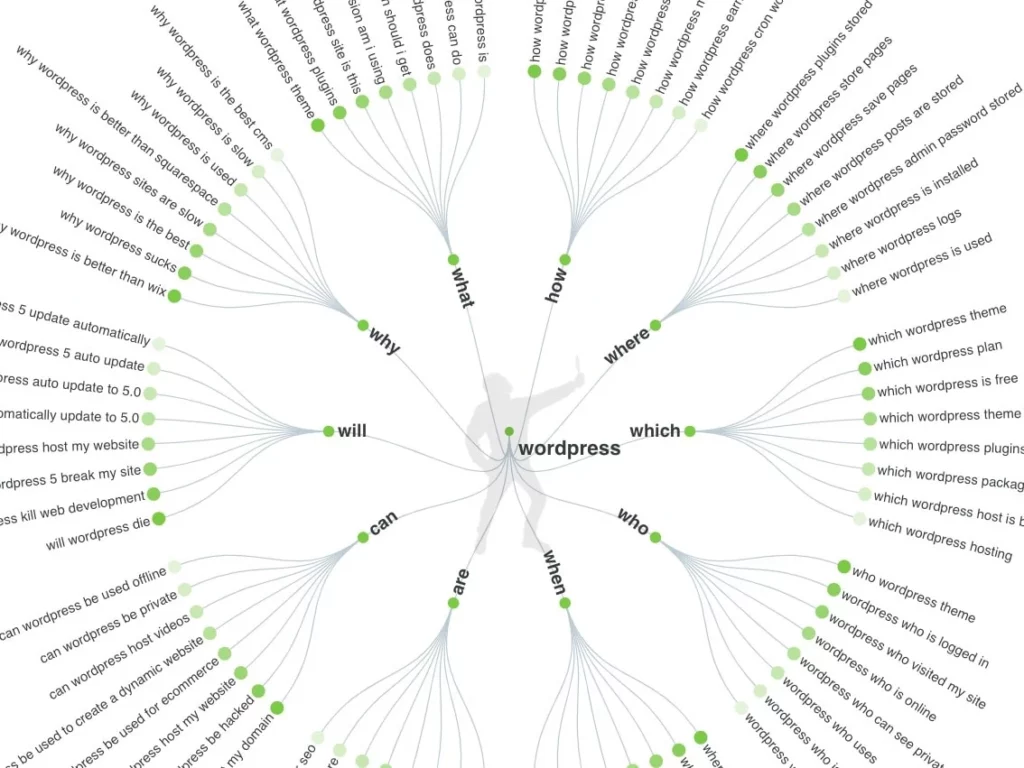
You can also arrange these questions alphabetically or numerically (for example, 15-inch vs. 17-inch laptops). You can download these reports in a CSV format.
AnswerThePublic’s strongest suit is its visual breakdown of search intent data, which makes it easy to form connections between datasets. You can view the results in a wheel, list, or tabular format.
Pricing: $11 to $199, depending on the plan
Alternative: AlsoAsked
FAQ
How to Identify High-Intent Keywords?
High-intent keywords are transactional, indicating that you’re considering buying a product or a service. They represent users at the tail end of a marketing funnel, known as the “bottom of the funnel” (BOFU).
Some examples of high-intent or BOFU keywords include “buy Nike running shoes” or “best antivirus for small businesses.”
Once you identify them, you can focus on designing or optimizing your content using these keywords to match the search intent for target users and drive conversions.
How to Optimize Your Content for Search Intent?
To optimize your content for search intent, you must understand the motivation behind the user’s search, and tailor your content or web pages to this intent.
This ensures you understand what your audience wants and that your content meets their needs at each stage of their buying journey.
How Can Search Intent Analysis Benefit My Overall SEO Strategy?
Search intent offers a glimpse into users’ innermost thoughts, revealing why they search what they do.
This allows you to create meaningful, relevant content that addresses their immediate needs.
When your content gives your users the exact information they are looking for, you drive more people to your site and increase your site’s visibility in search rankings.
All of these actions support your overall SEO strategy and improve its performance.
Empower Your Content Team
Our end-to-end content optimization solution empowers your team to crack the Google algorithm, craft exceptional content, and achieve remarkable organic search results.
